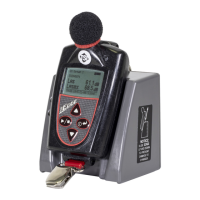Appendix B
B: Glossary of Terms
Lavg (Average Level)
Lavg is the average sound level measured over the run time. This becomes a bit confusing when
thresholds are used. Any sound below the threshold is not included in this average. Remember that
sound is measured in the logarithmic scale of decibels therefore the average cannot be computed by
simply .adding the levels and dividing by the number of samples. When averaging decibels, short
durations of high levels can significantly contribute to the average level. Example: Assume the
threshold is set to 80 dB and the Exchange Rate is 5 dB (the settings of OSHA’s Hearing
Conservation Amendment). Consider taking a one-hour noise measurement in an office where the
A-weighted sound level was typically between 50 dB and 70 dB. If the sound level never exceeded
the 80 dB threshold during the one hour period, then the Lavg would not indicate any reading at all. If
80 dB was exceeded for only a few seconds due to a telephone ringing near the instrument, then only
those seconds will contribute to the Lavg resulting in a level perhaps around 40 dB (notably lower
than the actual levels in the environment).
L
EP,D
Daily personal noise exposure level.
Leq (Equivalent Level)
The true equivalent sound level measured over the run time. The term Leq is functionally the same as
Lavg except that it is only used when the Exchange Rate is set to 3 dB and the threshold is set to
none.
Logging
(Also called Data Logging.) Certain measurements, such as average level (Lavg) and maximum level
(max), can be recorded by the dosimeter at regular intervals. For example: A dosimeter is set to log
Lavg and max at one minute logging intervals. If the dosimeter runs for one hour, then it would log
60 Lavg results and 60 max levels. You would be able to see the average and maximum levels for
each minute of the one hour run time.
Maximum Level (Lmax)
The highest sampled sound level during the instrument’s run time allowing for the unit’s Response
Time setting (Fast or Slow).
Measurement Range
The decibel range within which the unit’s measurements are valid.
Minimum Level (Lmin)
The lowest sampled sound level during the instrument’s run time allowing for the unit’s Response
Time setting (Fast or Slow).
Noise Floor
In a “Perfectly Quiet” room, the electrical noise produced by the microphone is approximately 35 dB
on A-weighting and 45 dB on C-weighting. These levels are known as the Noise Floor of the
instrument. The Noise Floor can cause inaccurate measurements at low measurement levels.

